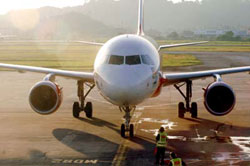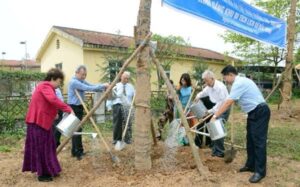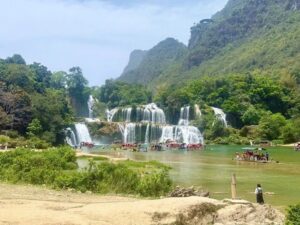A passenger jet powered in part by vegetable oil successfully completed a two-hour flight on Tuesday, December, 30, 2008 to test a biofuel that could lower airplane emissions and cut costs, Air New Zealand said.
 One engine of a Boeing 747-400 airplane was powered by a 50-50 blend of oil from jatropha plants and standard A1 jet fuel.This year has seen an unprecedented push for alternative fuels by airlines, which were slammed by skyrocketing oil prices earlier in 2008 and are now bracing for a falloff in air travel in the face of a global economic slowdown.While Air New Zealand couldn't say whether the blend would be cheaper than standard jet fuel since jatropha is not yet produced on a commercial scale, the company expects the blend to be "cost competitive," according to company spokeswoman Tracy Mills.Biofuels were once regarded as impractical for aviation because most freeze at the low temperatures encountered at cruising altitudes. But tests show jatropha, whose seeds yield an oil already used to produce fuels like biodiesel, has an even lower freezing point than jet fuel.Air New Zealand Chief Executive Rob Fyfe called the flight "a milestone for the airline and commercial aviation.""Today we stand at the earliest stages of sustainable fuel development and an important moment in aviation history," he said shortly after the flight. The company's goal is to become the world's most environmentally sustainable airline.The flight was the first to use jatropha as part of a biofuel mix.In February, Boeing and Virgin Atlantic carried out a similar test flight that included a biofuel mixture of palm and coconut oil - but was dismissed as a publicity stunt by environmentalists who said the fuel could not be produced in the quantities needed for commercial aviation use.Biofuels emit as much carbon as kerosene-based jet fuel, but jatropha - a Mexican plant that grows in warm climates - absorbs about half the carbon that jatropha-based fuels release. Air New Zealand's proposed blend, for example, would mean a one-quarter reduction in the carbon footprint of standard jet fuel.Many biofuels - like ethanol, which is produced from corn - have been blamed for raising the price of food by diverting it from kitchen tables to engines. While the link between biofuels and grain prices is debatable, Mills said that jatropha plants would not compete with food or other commercial crops since it can grow on land that would make poor farmland and needs little water."Ethanol is a first generation biofuel; jatropha a second generation biofuel that doesn't compete for land with food production," Mills said.The test flight out of Auckland International Airport included a full-power takeoff and cruising to 35,000 feet (10,600 meters), where the crew manually set all four engine controls to check for identical performance readings among the biofuel-powered engine and those using jet fuel. Pilots also switched off the fuel pump for the biofuel engine at 25,000 feet (7,600 meters) "to test the lubricity of the fuel," ensuring its friction in the pipe did not slow its flow to the engine.Capt. David Morgan, the airline's chief pilot who was on board the airplane, said results from the flight tests will provide the company and its partners with invaluable data to help jatropha become a certified aviation fuel.The checks were "designed to test the biofuel to the fullest extent," Morgan said.While the airline heralded the flight as successful, Air New Zealand Group Manager Ed Sims cautioned that it will be at least 2013 before the company can ensure easy access to the large quantities of jatropha it would need to use the biofuel on all of its flights."Clearly we are a long, long way from being able to source commercially quantifiable amounts of the fuel and then be able to move that amount of fuel around the world to be able to power the world's airlines is still some years off," Sims told New Zealand's National Radio.The company bought the seeds from plantations in East Africa and India that total 309,000 acres (125,000 hectares). The company hopes that by 2013, 10 percent of its flights will be powered, at least in part, by biofuels, Mills said. Most of those using the blend would be short haul domestic services. Simon Boxer, of environmental group Greenpeace New Zealand, said it was inevitable that airlines would show greater interest in sustainable biofuels as travelers become more aware of the harm that air travel causes the environment. But he said it wasn't clear whether jatropha was really sustainable. He questioned what the environmental impact would be if jatropha grew popular and more land and resources were needed to produce it on a commercial scale. The flight was a joint venture by Air New Zealand, airplane maker Boeing, engine maker Rolls Royce and biofuel specialist, UOP Llc, a unit of Honeywell International. The flight, initially scheduled for earlier this month, was postponed after an Air New Zealand A320 Airbus crashed off Perpignan on the south coast of France on Nov. 27, 2008 killing all seven on board.
One engine of a Boeing 747-400 airplane was powered by a 50-50 blend of oil from jatropha plants and standard A1 jet fuel.This year has seen an unprecedented push for alternative fuels by airlines, which were slammed by skyrocketing oil prices earlier in 2008 and are now bracing for a falloff in air travel in the face of a global economic slowdown.While Air New Zealand couldn't say whether the blend would be cheaper than standard jet fuel since jatropha is not yet produced on a commercial scale, the company expects the blend to be "cost competitive," according to company spokeswoman Tracy Mills.Biofuels were once regarded as impractical for aviation because most freeze at the low temperatures encountered at cruising altitudes. But tests show jatropha, whose seeds yield an oil already used to produce fuels like biodiesel, has an even lower freezing point than jet fuel.Air New Zealand Chief Executive Rob Fyfe called the flight "a milestone for the airline and commercial aviation.""Today we stand at the earliest stages of sustainable fuel development and an important moment in aviation history," he said shortly after the flight. The company's goal is to become the world's most environmentally sustainable airline.The flight was the first to use jatropha as part of a biofuel mix.In February, Boeing and Virgin Atlantic carried out a similar test flight that included a biofuel mixture of palm and coconut oil - but was dismissed as a publicity stunt by environmentalists who said the fuel could not be produced in the quantities needed for commercial aviation use.Biofuels emit as much carbon as kerosene-based jet fuel, but jatropha - a Mexican plant that grows in warm climates - absorbs about half the carbon that jatropha-based fuels release. Air New Zealand's proposed blend, for example, would mean a one-quarter reduction in the carbon footprint of standard jet fuel.Many biofuels - like ethanol, which is produced from corn - have been blamed for raising the price of food by diverting it from kitchen tables to engines. While the link between biofuels and grain prices is debatable, Mills said that jatropha plants would not compete with food or other commercial crops since it can grow on land that would make poor farmland and needs little water."Ethanol is a first generation biofuel; jatropha a second generation biofuel that doesn't compete for land with food production," Mills said.The test flight out of Auckland International Airport included a full-power takeoff and cruising to 35,000 feet (10,600 meters), where the crew manually set all four engine controls to check for identical performance readings among the biofuel-powered engine and those using jet fuel. Pilots also switched off the fuel pump for the biofuel engine at 25,000 feet (7,600 meters) "to test the lubricity of the fuel," ensuring its friction in the pipe did not slow its flow to the engine.Capt. David Morgan, the airline's chief pilot who was on board the airplane, said results from the flight tests will provide the company and its partners with invaluable data to help jatropha become a certified aviation fuel.The checks were "designed to test the biofuel to the fullest extent," Morgan said.While the airline heralded the flight as successful, Air New Zealand Group Manager Ed Sims cautioned that it will be at least 2013 before the company can ensure easy access to the large quantities of jatropha it would need to use the biofuel on all of its flights."Clearly we are a long, long way from being able to source commercially quantifiable amounts of the fuel and then be able to move that amount of fuel around the world to be able to power the world's airlines is still some years off," Sims told New Zealand's National Radio.The company bought the seeds from plantations in East Africa and India that total 309,000 acres (125,000 hectares). The company hopes that by 2013, 10 percent of its flights will be powered, at least in part, by biofuels, Mills said. Most of those using the blend would be short haul domestic services. Simon Boxer, of environmental group Greenpeace New Zealand, said it was inevitable that airlines would show greater interest in sustainable biofuels as travelers become more aware of the harm that air travel causes the environment. But he said it wasn't clear whether jatropha was really sustainable. He questioned what the environmental impact would be if jatropha grew popular and more land and resources were needed to produce it on a commercial scale. The flight was a joint venture by Air New Zealand, airplane maker Boeing, engine maker Rolls Royce and biofuel specialist, UOP Llc, a unit of Honeywell International. The flight, initially scheduled for earlier this month, was postponed after an Air New Zealand A320 Airbus crashed off Perpignan on the south coast of France on Nov. 27, 2008 killing all seven on board.













